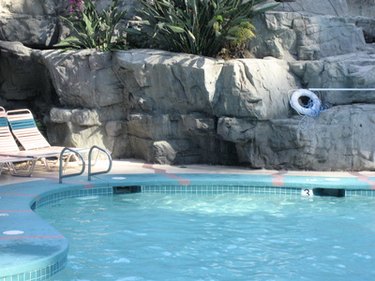
Rebar is the reinforcing steel or bar that is used to give support to a concrete structure. Rebar bonds well with the swimming pool concrete structure and it is one of the most important materials required for the construction of any type of swimming pool. Rebar is bendable. It can be used for many swimming pool designs, including the steps.
Size of the rebar
Video of the Day
The size of the rebar for use in pools is No. 5. No. 5 rebar will have a diameter size of 0.625 inches. The weight will be in the range of 1,000 to 1,100 pounds. The metric diameter will be 15.8 millimeters and the metric bar size will be No. 16.
Video of the Day
Rebar spacing
Proper rebar spacing is important to the structural strength of the swimming pool foundation. In most locations the ideal space between two adjacent rebars should be 2 1/2 inches. Local building codes may vary, so determine the correct rebar spacing for your area and for your specific swimming pool project.
Rebar grading
There are three types of grades in rebars. They are grade 40, 60 and 75. The rebar used for swimming pool construction is grade 40 deformed bars conforming to the standard of ASTM A615. Grade 40 means that the yield strength is 40,000 psi and the code allowed strength is 20,000 psi. PSI means per square inch. Deformed bars mean that the rebar must have protrusions that will help the bar to bond mechanically with the swimming pool structure. When you say ASTM A615, it means that the rebar has been manufactured from hot rolled new billets.
Rebar installations
The rebar should be of the bar size and the spacing must be based on the swimming pool structural plan. The rebar must be of the same grade that is mentioned in the swimming pool structural plan. The protection coverage of the rebar must be specified in the code or the structural plan. The rebar must be tied or held in one place so that there is no vibration or movement of the rebar. The placement of the rebar should be in such a manner that proper encasement should be enabled in gunite or shortcrete. Shortcrete or gunite is concrete that is projected at a very high velocity into the surface. If the rebar is not properly encased it means that the concrete is not reinforced properly. There could also be relective cracking if the rebar is not securely tied.